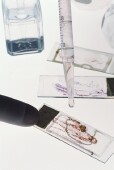
FRIDAY, April 1 (HealthDay News) — At-home pregnancy tests can tell you unequivocally in minutes whether a baby is on the way and if it is time to call your doctor.
But, at-home genetic tests — which may offer tantalizing clues about future health risks — are still in their infancy, and genetic counselors are concerned that the results may puzzle or even panic consumers who don’t seek professional guidance.
The explosion of direct-to-consumer genetic tests over the past several years has made it seemingly simple to test for a wide variety of medical scenarios. A swab of the cheek or a vial of blood can discern whether one is a carrier of an inherited disorder such as cystic fibrosis, for instance, or predict the risk for diseases such as breast cancer or Parkinson’s. Newer tests purportedly predict how people might respond to a specific drug or medical treatment.
But shelling out several hundred dollars or more for one of these tests — which are widely available online — does not equip consumers to understand the findings or their repercussions, genetic counselors say. Because people might base medical decisions on the results, the U.S. Food and Drug Administration decided this month to restrict the tests on a case-by-case basis.
“To me, it’s still very much in the recreational realm,” said Caroline Lieber, a genetic counselor and director of the graduate program in human genetics at Sarah Lawrence College in Yonkers, N.Y. “The concern I have is the majority of the people feel knowledge is power, whereas most haven’t thought through the implications at all.”
The U.S. Human Genome Project, begun 21 years ago to map out which genes are responsible for both physical and functional traits, led to unprecedented knowledge about how genes affect people’s propensity for dozens of traits and conditions.
But few predicted at the outset the complications that capitalism might create. A recent undercover study of 15 direct-to-consumer tests by the U.S. Government Accountability Office found “egregious examples of deceptive marketing, in addition to poor or non-existent advice from supposed consultation experts,” according to a recent report in The Lancet.
The bottom line, Lieber said, is that an increasing number of companies’ bottom lines are impacted by people’s desires to live longer, healthier lives.
“My sense right now is it’s very much about those companies making money,” said Lieber, whose human genetics master’s program at Sarah Lawrence is the nation’s first and largest. “The cynic in me says they’re doing it mostly to make money, but I do think that’s changing. Now phone counseling is being offered, and it’s better than not having anything.”
Whether conducted by phone, Internet or in person, such counseling — if done by qualified experts — can help translate hard science into information that the average consumer can understand. For example, if a genetic test shows a low risk of diabetes, that doesn’t mean that diet, exercise and other healthy lifestyle measures aren’t necessary, said Dr. Robb Rowley, an internal medicine physician at Amigenics, a Las Vegas-based genetic testing and counseling group.
“At this point, I still recommend genetic testing be done through a health-care provider,” said Rowley, whose patients mostly consult on their predisposition to cancer. “Some have dire consequences . . . and without having a physician involved, people might do something [to change their lives] that they wouldn’t otherwise do.”
Lieber said she thinks most who order at-home tests are unaware counseling exists to help them interpret the results. Others, she suspects, don’t want the scrutiny of outsiders knowing their personal medical history.
“Probably my biggest concern is to have them understand genetic counselors are not there to tell people what to do. I think that’s a misperception about the field,” she said. But, “if the results make them view themselves not as a person, but as a carrier for something — if they haven’t thought about it — it can truly be damaging.”
Rowley said the ultimate scenario, which he predicts is five to 10 years out, is to be able to use each individual’s unique DNA to optimize their care.
“The goal in the future is to be able to take that individual and say, ‘Don’t worry about osteoporosis, let’s focus on your cardiovascular health, and by the way, this medication has a 40 percent chance of working for you,'” Rowley said. “To a limited extent, we’re there now.”
More information
For more on the issue of at-home genetic testing, go to Federal Trade Commission.

